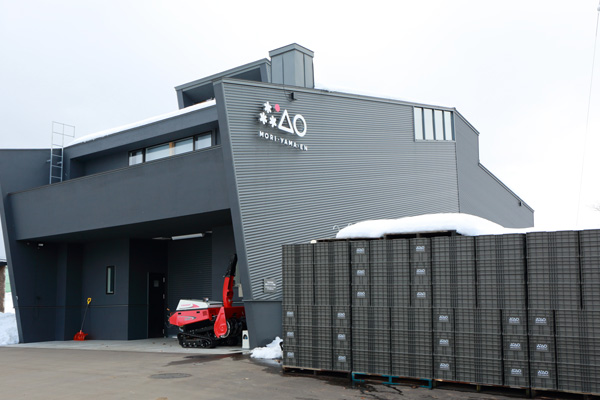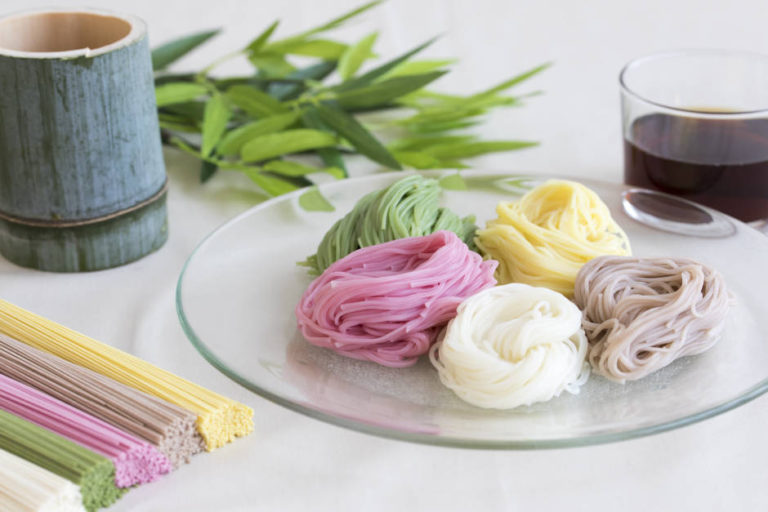MORIYAMAEN’s TEKIKAKA CIDRE is a beam of light for the future of the ap-ple homeland

MORIYAMAEN has been harvesting apples in Hirosaki for over one hundred years. Within this area and its rich apple farming history, this apple orchard had feelings of im-pending doom toward conventional apple farming, which prompted the orchard to think out of the box with many new and innovative ideas.
The man who dared to tackle fundamental issues in apple farming

The Hirosaki area is surrounded by majestic mountains such as Mt. Iwaki and the Shi-rakami Mountain Range. The seasons here are sharply defined, with sudden cold weather during autumn to winter, making it the optimal location for apple harvesting due to the pronounced temperature differences between day and night.
The September to November harvest season sees the foothills of Mt. Iwaki spotted with trees heavy with red fruit, a spectacular scene that represents the homeland of apple farm-ing.
MORIYAMAEN is an apple orchard that has been harvesting apples here for over one hundred years. Toshihiko Moriyama, the 4th generation head of the orchard, had been operating his 10-hectare orchard as his predecessors had for many years. However, he started to question the fundamental structure of apple farming.

“In the past, farmers handled each apple ten times with their hands before shipping it out. Even now, with labor-saving measures in place, apples are still handled five times. Apple farmers put no limit on the time and effort invested in their crops, if it meant a higher price for apples. The tradition of family members working in the orchard—in other words “free labor”—was prominent up to my father’s generation. At any rate, the production is not efficient at all, and the risk of natural disasters is also high. The returns do not reflect the risks we take as apple farmers. Although this region is famous for its apples, in reality, the number of local apple farmers has been decreasing every year. Many farmers balk at the thought of handing down their orchards to their children. I completely understand their feelings.”
Excluding the harvest and shipment months of September to November, most of the labor apple farmers do across the year are “throw-away tasks” such as pruning and thinning. Needless to say, the only time their labor results in an income is during the shipment peri-od. Furthermore, the price for damaged fruit tends to drop alarmingly, even for slight damage or blemishes caused by natural disasters such as typhoons or hail. This is because fresh apples are evaluated not only for their taste, but for their appearance as well, even if they are not special fruits for gifts.
In this environment, Moriyama had an issue against the fruit-thinning process.

The thinning process takes place during June to August, when the apples are still the size of a golf ball. Only apples in good condition are left, and the rest are picked. Although this process is crucial for ensuring that healthy apples receive nutrients from the tree for larger fruit, a staggering 90% of apples are picked using this procedure. The plucked ap-ples are said to have been left on the ground or discarded, as there was no other way of using them.
“I always felt that, along with the quantity of apples picked and discarded, the labor nec-essary for thinning was a waste of precious time. I calculated it and noticed that approxi-mately 3,000 hours were spent on this task every year—which makes up approximately 30% of all annual labor. I spent many days and nights thinking of a way to effectively in-corporate this enormous amount of labor towards something.”

After much trial and error, Moriyama hit on an idea to create cider made from tekikaka (thinned apples).
Cider products in Japan are usually manufactured with ripe, fresh apples, and producing cider with unripe tekikaka proved to be a daunting task. However, Moriyama worked on his cider for five years to successfully launch the TEKIKAKA CIDRE made from thinned apples.
“The product name TEKIKAKA comes from the unripened fruit picked for thinning. These unripe apples contain ten times more polyphenol than ripe apples. People often mistake TEKIKAKA CIDRE as cider made from apples gathered from the ground, after they had been discarded during thinning. This is not true, and the cider is made from ap-ples that are harvested and not dropped on the ground.”
An unprecedented cider made from apples picked for thinning.

Cider is a slightly sparkling apple wine made by adding yeast to extracted apple juice. It has been steadily gaining popularity in Japan as an aperitif to take the place of champagne and beer. Cider is already popular in the U.S. and Europe, holding a spot right after craft beer, offering many brands and entertaining many cider enthusiasts as well.
“About 20 years ago, I had an opportunity to go for a long-term stay in Canada. My wife and I drank a lot of cider there. My wife especially enjoyed cider, and we used to talk about making and selling cider, since we had an apple orchard. With this, I started to wonder if thinned apples could be used for cider.”
The apples used for TEKIKAKA CIDRE are harvested during the month of July. Stand-ard harvesting methods do not ensure pesticide safety during this period, as the harvest is more than a month earlier than ripe apples. Due to this, in 2013, Moriyama started his bat-tle towards developing new growing methods that would produce safe apples during the thinning process.
Moriyama tried agrochemical-free growing the first year. However, due to pest hazards that affected the surrounding environment as well, he decided that pesticide-free farming was not an option. From the second year, he transferred to specially-cultivated growing methods, and reduced the frequency of using pesticides to 50% or less than the regional standard, and received certification for this. The reason for receiving certification was to ensure objective safety through offering product traceability to the public.
Measures such as communication disruption technologies using insect hormones were also fully incorporated to cut back on pesticide dependency. Experiments such as safe-guarding predator insects while allowing harmless pests to roam free were implemented, resulting in a stable tekikaka harvest after five long years.
Moriyama was finally able to take the juice extracted from the apples to the Aomori Pre-fectural Industrial Technology Research Center’s Hirosaki Industrial Research Institute in 2015, where he combined it with various yeasts to create trial ciders for his product.
However, this continued to be an unprecedented challenge. Problems such as the apples being too sour, or not being able to discover the optimal yeast for the ideal flavor came up. According to Moriyama, he was still grasping for straws in the dark up to six months before the product launch.

“The first trial product was made in 2014, at the Hirosaki Cider Society. It was so shock-ingly bad! Trials made from ripe apples were equally made. Through all the testing we did, being uncertain if a tasty product was possible, the sample made from thinned apples proved to be the most passable. I felt that cider made from thinned, unripe apples could possibly be the best choice.”
Moriyama had reasons to persevere even when the situation seemed bleak—it all stemmed from his experience visiting France’s Normandy region in October 2013.
The apples used for local cider in the Normandy region were bitter, sour, mouth-puckering apples the size of golf balls. This type of apple is specially harvested for cider production, and not for raw consumption. French ciders tend to be slightly bitter, like tea, and holding it in one’s mouth makes the tongue feel dry. These ciders offer a picturesque flavor that is dry, deep and not too sweet. It was a far cry from the sweet cider aperitif pre-sented in Japan.
“I was amazed. I knew that this was the flavor I was aiming for, and also was convinced that my thinned apples, which were bitter and sour, were in fact the best apples to create cider!”
Instead of focusing on effectively using thinned apples that were doomed to be discarded, he decided to apply these thinned apples to create delicious cider. Moriyama had no doubts and continued his experiments at a greater pace. With the cooperation of Fujiko Aoyama, whom he met at the Hirosaki Cider Society, Moriyama at last discovered the optimal yeast for his cider and completed his product, which featured an almost ideal taste.
With this, in hopes of realizing the product, the annual harvesting schedule was adjusted so no pesticides were used during thinning tasks. Moriyama did not hold back in investing a great amount in a cider factory beside his orchard. In 2017, he started selling TEKIKAKA CIDRE, as the first cider product in Japan that uses thinned apples.
Talk of this cider spread gradually, and the product received two stars at the Japan Cider Awards tasting category, in which the winning products were selected by cider aficiona-dos. Although TEKIKAKA CIDRE started off as a bottled product, many requests al-lowed Moriyama to start shipping it in barrels for restaurants and bars.
Although gradually, Moriyama’s painstaking efforts over the years have steadily started to pay off.
Establishing farming as a growing industry through efficiency and profitability

Along with manufacturing cider products with apples picked during the thinning process, Moriyama also fully incorporates IT to improve productivity for conventional apple farm-ers.
He has developed a special smartphone application for growing fruit, which allows each apple to be tagged with a unique QR code, so that all information from pruning, thinning, bagging processes and labor times, along with pesticide use can be stored in one’s smartphone. All staff members can share this visualized farming status, of which is ex-pected to dramatically increase the efficiency.
Moriyama plans to release his app to the public as well (scheduled for release in April 2019). He hopes that not only apple farmers, but other fruit growers can also use his ap-plication for their convenience.

“Basically, I wanted to do something about the decreasing number of local apple farmers, and also about how so many were turning their back on the primary industries of Japan. Instead of ‘going to the city because farming doesn’t pay,’ I wanted to construct a system in which people who put effort into producing something could be rewarded. Farming still has so much room for growth, and it is such an interesting industry. I wish that more people would recognize this.”
There is a revolution taking place in apple farming, something that may transform primary industries into growth sectors. The sprouts that will support the future of apple growing are growing powerfully in the homeland of Japanese apples.






